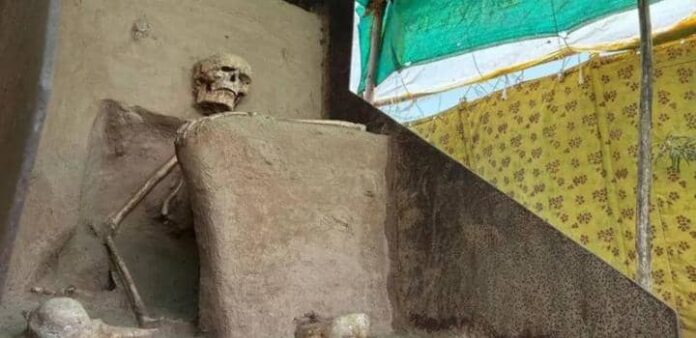A 1,000-year-old human skeleton, buried in a sitting cross-legged position, has been relocated to the Archaeological Experiential Museum in Vadnagar, Gujarat, India.
The skeleton, believed to belong to the Solanki dynasty, which ruled parts of modern-day Gujarat between 940 to 1300 CE, was unearthed in 2019. However, due to bureaucratic delays, it was left in a temporary tarpaulin shelter near the excavation site, exposed to natural elements and without proper security.
The skeleton’s journey to the museum was a long-awaited one. According to Mahendra Surela, curator of the Archaeological Experiential Museum, the skeleton was transported with utmost care and under expert supervision.
“We will examine the skeleton before deciding on its display,” said Surela. “It is currently placed next to the reception, fenced in by a protective barrier, and may be shifted to the second floor where a photograph of the skeleton is already displayed.”
Archaeologist Abhijit Ambekar, who discovered the skeleton, expressed his happiness that the significant find is finally getting the attention it deserves. “This skeleton is a rare discovery, with similar remains found at only three other sites in India,” Ambekar said. “The remains could shed light on the phenomenon of ‘samadhi burials,’ an ancient burial practice among Hindus where revered figures were buried rather than cremated.”
The skeleton’s preservation is attributed to the undisturbed soil around it, which displayed characteristics that aided preservation. With its new home at the museum, the skeleton will soon be displayed to the public, offering a glimpse into ancient India’s rich history and culture.
The skeleton’s discovery is significant not only because of its age but also due to its unique burial position. The sitting cross-legged posture is rare, and experts believe that it may provide valuable insights into ancient Indian burial practices.
The relocation of the skeleton to the museum marks a new chapter in its journey. With proper care and preservation, the skeleton will be showcased to the public, allowing people to learn about and appreciate India’s rich cultural heritage. As the museum prepares to display the skeleton, visitors can look forward to gaining a deeper understanding of ancient India’s history and traditions.

